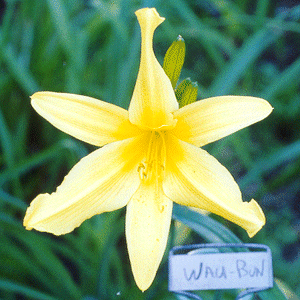
Introduced: 1929 |

|
One year after the first description, A.B. Stout described it as:
" The Daylily Wau-Bun arose as a hybrid seedling recently reared at The New York Botanical Garden and now being propagated as a clon for culture as a garden plant. The horticultural name Wau-Bun was first employed in print in a popular description of the plant which was published in "House andGarden" (55: 126. 1927). It has for its immediate ancestry the two species Hemerocallis flava and H. aurantiaca and the Luteola Daylily which is in itself a hybrid. For colored illustrations of these parents see Addisonia 14: plates 457 and 461, and plate 485 of this number. An unusual form of flower due to the folded and twisted character of the petals, large size of flower, rich yellow colorings, and a good habit of growth give this clon much individual charm as a plant for the flower garden. The Winnebago Indian name Wau-Bun, which signifies the early morn with its rising sun, has been chosen as a suitable horticultural name for this hybrid clon.
A plant of the Wau-Bun Daylily is, in comparison with the entire group of daylilies, of semi-robust stature. The foliage is bending and arching and stands at a general level of about thirty inches, and it remains freshly green throughout the autumn. The scapes are ascending to a height several inches above the dome of leaves, and are branching near the top. The flower is of a large size for daylilies; the sepals are broad and smoothly and stiffly recurving; the petals are broad, spreading rather than strongly recurving, and in the outer half they are folded backward along the midrib and also somewhat twisted near the tip. This gives a form of flower that is not seen among the other named clons of daylilies. The color of both sepals and petals is the shade of yellow known as light cadmium over which there is a delicate sprinkling of faint fulvous red. There is also the glistening in sunlight as if the surface were sprinkled with numerous tiny flecks of gold - a quality very generally seen in flowers of daylilies. The period of blooming is mid-summer. The original seedling has been fully self-incompatible, as are many of the daylilies, and the clon can not be expected to produce seeds to self- and to close-pollination or to intra-clonal pollinations. Capsules and seeds are freely produced to compatible cross-pollinations. The capsules are about one and one half inches in length, obovate with a rather truncate apex; the longtudinal grooves are somewhat coarse and shallow. "
( cited from: Addisonia, 1930, vol. 15, p. 15 (plate 488) )